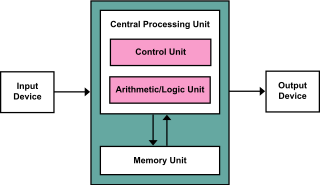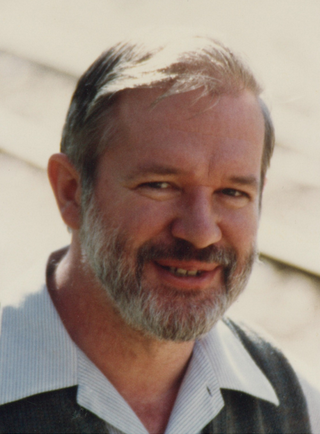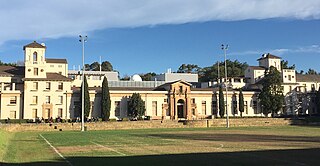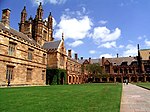
The IAS machine was the first electronic computer built at the Institute for Advanced Study (IAS) in Princeton, New Jersey. It is sometimes called the von Neumann machine, since the paper describing its design was edited by John von Neumann, a mathematics professor at both Princeton University and IAS. The computer was built under his direction, starting in 1946 and finished in 1951. The general organization is called von Neumann architecture, even though it was both conceived and implemented by others. The computer is in the collection of the Smithsonian National Museum of American History but is not currently on display.

The ILLIAC I, a pioneering computer in the ILLIAC series of computers built in 1952 by the University of Illinois, was the first computer built and owned entirely by a United States educational institution.
The Cyclone is a vacuum-tube computer, built by Iowa State College at Ames, Iowa. The computer was commissioned in July 1959. It was based on the IAS architecture developed by John von Neumann. The Cyclone was based on ILLIAC, the University of Illinois Automatic Computer. The Cyclone used 40-bit words, used two 20-bit instructions per word, and each instruction had an eight-bit op-code and a 12-bit operand or address field. In general IAS-based computers were not code compatible with each other, although originally math routines which ran on the ILLIAC would also run on the Cyclone.

CSIRAC, originally known as CSIR Mk 1, was Australia's first digital computer, and the fifth stored program computer in the world. It is the oldest surviving first-generation electronic computer (the Zuse Z4 at the Deutsches Museum is older, but was electro-mechanical, not electronic), and was the first in the world to play digital music.
Ronald Newbold Bracewell AO was the Lewis M. Terman Professor of Electrical Engineering of the Space, Telecommunications, and Radioscience Laboratory at Stanford University.

The von Neumann architecture—also known as the von Neumann model or Princeton architecture—is a computer architecture based on a 1945 description by John von Neumann, and by others, in the First Draft of a Report on the EDVAC. The document describes a design architecture for an electronic digital computer with these components:

The Powerhouse Museum is the major branch of the Museum of Applied Arts & Sciences (MAAS) in Sydney, and owned by the Government of New South Wales. The Powerhouse is a collection of museums with its main centre in Ultimo, New South Wales, the others being the historic Sydney Observatory at Observatory Hill, and the newer Museums Discovery Centre at Castle Hill.
For other uses, see Chris Wallace (disambiguation).
ILLIAC was a series of supercomputers built at a variety of locations, some at the University of Illinois at Urbana–Champaign. In all, five computers were built in this series between 1951 and 1974. Some more modern projects also use the name.

Ruby Violet Payne-Scott was an Australian pioneer in radiophysics and radio astronomy, and was one of two Antipodean women pioneers in radio astronomy and radio physics at the end of the second world war, Ruby Payne-Scott the Australian and Elizabeth Alexander the New Zealander.

The Paul Wild Observatory, also known as the Narrabri Observatory and Culgoora Observatory, is an astronomical research facility located about 24 km west of Narrabri, New South Wales, Australia. It is the home of the Australia Telescope Compact Array, and the Culgoora Solar Observatory.
Minimal instruction set computer (MISC) is a central processing unit (CPU) architecture, usually in the form of a microprocessor, with a very small number of basic operations and corresponding opcodes, together forming an instruction set. Such sets are commonly stack-based rather than register-based to reduce the size of operand specifiers.

Allan George Bromley was an Australian historian of computing who became a world authority on many aspects of early computing and was one of the most avid collectors of mechanical calculators.

The MISTIC, or Michigan State Integral Computer, was the first computer system at Michigan State University and was built by its students, faculty and staff in 1957. Powered by vacuum tubes, its design was based on ILLIAC, the supercomputer built at University of Illinois at Urbana–Champaign, a descendant of the IAS architecture developed by John von Neumann.

The School of Physics is a constituent body of the Faculty of Science at the University of Sydney, Australia.
Allan James Yeomans is an agriculturist, design engineer, author, lecturer, and inventor. He argues that we can bring global warming and climate under control and restore weather systems to normal at negligible cost while simultaneously improving our wealth and standard of living.

The University of Illinois Department of Computer Science is the academic department encompassing the discipline of computer science at the University of Illinois Urbana-Champaign. According to U.S. News & World Report, both its undergraduate and graduate programs rank in the top five among American universities, and according to Computer Science Open Rankings, the department ranks equally high in placing Ph.D. students in tenure-track positions at top universities and winning best paper awards. The department also ranks in the top two among all universities for faculty submissions to reputable journals and academic conferences, as determined by CSRankings.org. From before its official founding in 1964 to today, the department's faculty members and alumni have contributed to projects including the ORDVAC, PLATO, Mosaic, JavaScript and LLVM, and have founded companies including Siebel Systems, Netscape, Mozilla, PayPal, Yelp, YouTube, and Malwarebytes.
Sir John Percival Vissing Madsen FAA was an Australian academic, physicist, engineer, mathematician and Army officer.
The Eggatron was a digital counter that recorded when an egg was laid in an effort to determine the most productive hens. The device was tested using battery cages at CSIRO's Poultry Research Centre at Werribee.
John Markus Blatt was an Austrian-born American theoretical physicist.













